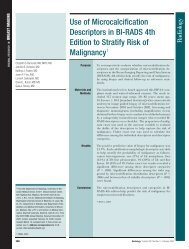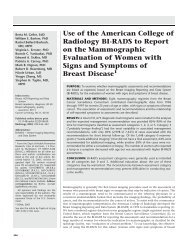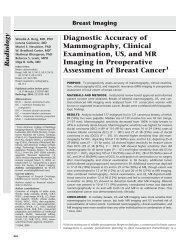Breast radiotherapy in women with pectus excavatum ... - Quantason
Breast radiotherapy in women with pectus excavatum ... - Quantason
Breast radiotherapy in women with pectus excavatum ... - Quantason
Create successful ePaper yourself
Turn your PDF publications into a flip-book with our unique Google optimized e-Paper software.
Short communication: ILD breast irradiation – <strong>pectus</strong> <strong>excavatum</strong>(a)(b)Figure 2. Pictures of the same patient <strong>with</strong> <strong>pectus</strong> <strong>excavatum</strong> at simulation <strong>in</strong> both (a) the sup<strong>in</strong>e and (b) the lateral decubitusset-ups.target volume <strong>with</strong><strong>in</strong> a range correspond<strong>in</strong>g to 95–107%of the prescription dose. In the case of patient D, the dosecoverage of the breast <strong>with</strong> the sup<strong>in</strong>e technique wasoptimal when only 48 Gy were prescribed at the ICRUpo<strong>in</strong>t <strong>in</strong> 24 fractions.<strong>Breast</strong> thickness ranged between 3.6 cm and 6.4 cm<strong>with</strong> the ILD technique and between 9.4 cm and 12 cm<strong>with</strong> the sup<strong>in</strong>e technique.The <strong>in</strong>ternal tangent fields’ simulation films of bothtechniques are shown <strong>in</strong> Figure 4. An overview of theresults of the dosimetry study is reported <strong>in</strong> Table 1. Thecentral lung distance ranged from 2.6 cm to 4 cm <strong>with</strong>the sup<strong>in</strong>e technique and from 0 cm to 1 cm <strong>with</strong> the ILDtechnique. The estimation of ILV20 ranged from 21% to34% <strong>with</strong> the sup<strong>in</strong>e technique and from 0% to 5% <strong>with</strong>the ILD technique. The maximal heart distance rangedbetween 0 cm and 1.7 cm and the estimation of the HV20from 0% to 9% <strong>with</strong> the sup<strong>in</strong>e technique. They wereboth zero <strong>with</strong> the ILD technique.The maximal width of lung and/or left ventricle thatreceived 20 Gy or more ranged between 2.1 cm and4.3 cm <strong>with</strong> the sup<strong>in</strong>e technique and between 0.5 cmand 1.1 cm <strong>with</strong> the ILD technique.Acute toxicityNo patient needed to have her <strong>radiotherapy</strong> suspended.Acute sk<strong>in</strong> toxicity at the completion of treatment wasmild and scored 1 (RTOG) for all four patients.Discussion<strong>Breast</strong> conserv<strong>in</strong>g treatments for breast cancers cansometimes be denied to <strong>women</strong> <strong>with</strong> <strong>pectus</strong> <strong>excavatum</strong>,where <strong>radiotherapy</strong> would <strong>in</strong>volve too high a risk ofpulmonary or cardiac toxicity.As previously discussed, the ILD is a simple, reproduciblebreast irradiation technique that can easily beimplemented <strong>in</strong> <strong>radiotherapy</strong> departments [10]. Morethan 500 patients have already been treated us<strong>in</strong>g thistechnique <strong>in</strong> our centre. Most often, this technique wasdecided on <strong>in</strong> the case of patients <strong>with</strong> large pendulousbreasts who needed breast alone irradiation. In thisstudy, we address the possibility of us<strong>in</strong>g this techniquefor <strong>women</strong> <strong>with</strong> <strong>pectus</strong> <strong>excavatum</strong> who need breast-aloneirradiation. We performed dosimetric studies on four<strong>women</strong> and report here the acute toxicity of thistechnique. Because the set-up device we used was toocumbersome to fit <strong>in</strong>to our dosimetric CT-scan, we couldnot perform whole lung and heart scann<strong>in</strong>g and thusdose–volume histogram comparisons were not available.We could nevertheless perform a number of CT slices thataccurately reflected the dosimetry of both the sup<strong>in</strong>e andthe ILD breast <strong>radiotherapy</strong> techniques. In addition, weused the two-dimensional <strong>in</strong>formation available from thesimulation field to estimate the percentage of theipsilateral lung and heart receiv<strong>in</strong>g 20 Gy or more [15].The formula we used was generated by Kong et al fromdata of 40 patients simulated for breast <strong>radiotherapy</strong> (22left side) <strong>in</strong> a sup<strong>in</strong>e position <strong>with</strong> a prescribed dose ofThe British Journal of Radiology, October 2006 787





